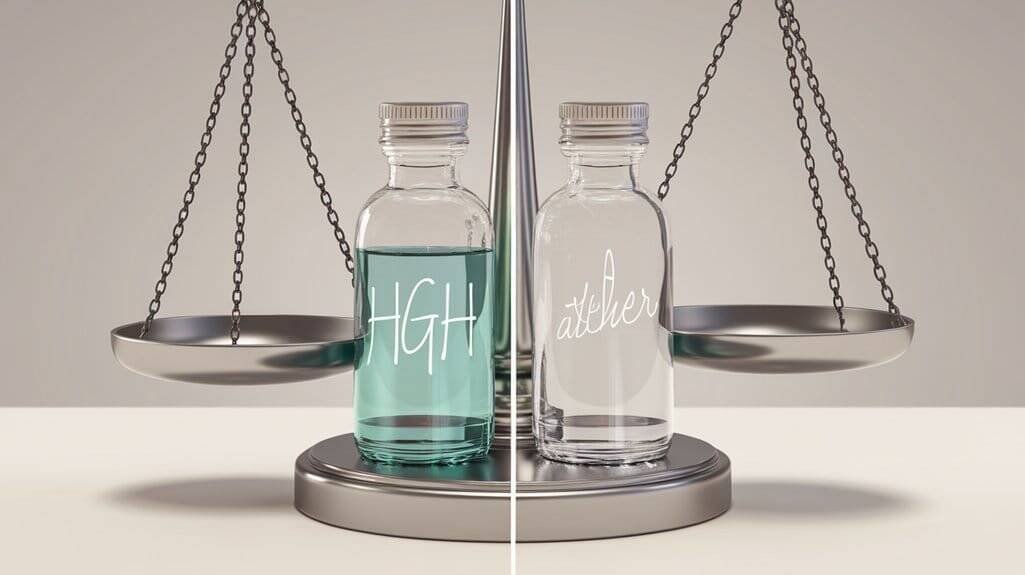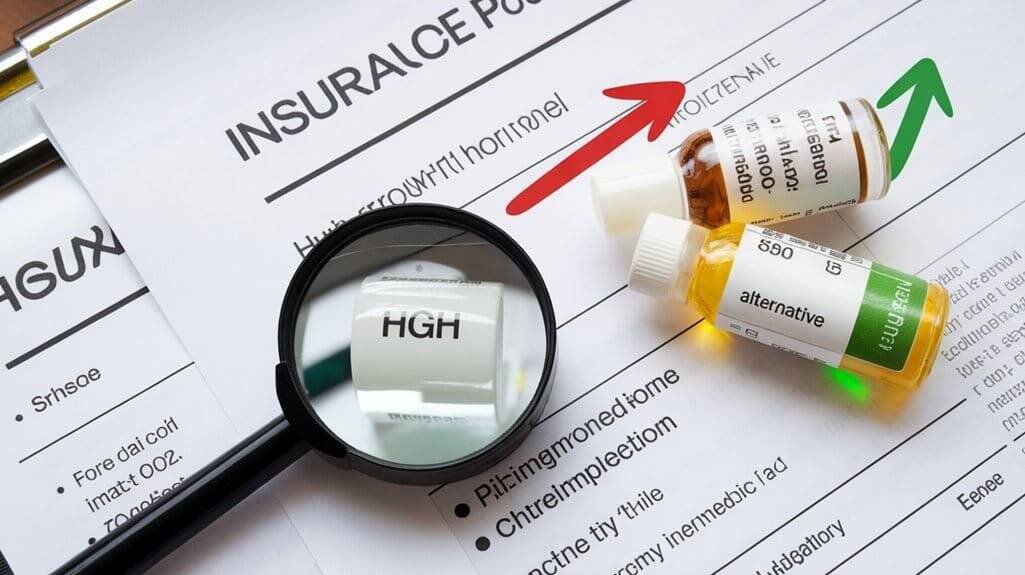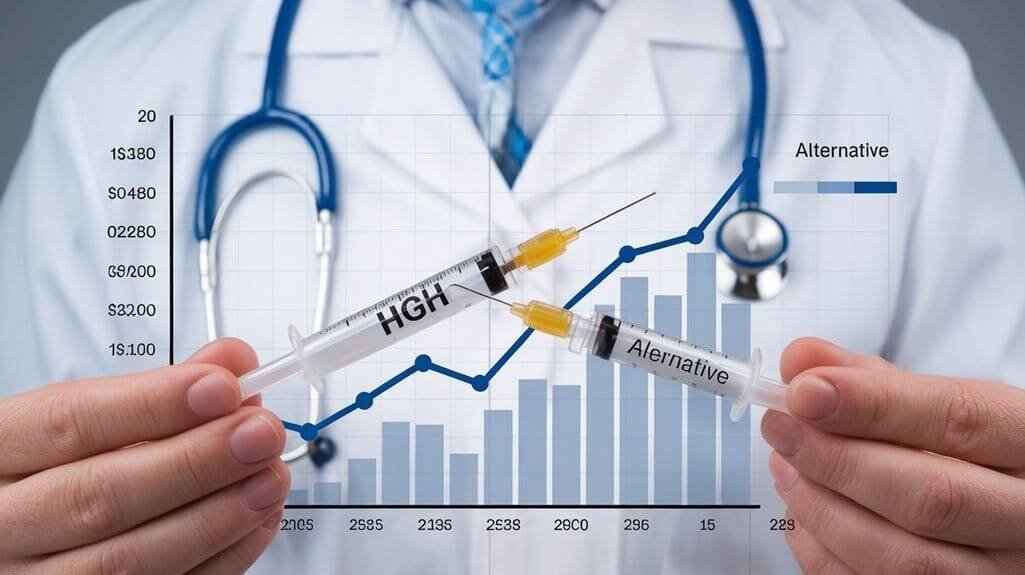When comparing HGH injections to alternatives, you'll see a notable cost difference. HGH therapy typically runs between $1,000 and $3,000 monthly, while options like Sermorelin can be as low as $200 to $400. Alternative injections, like Somatrogon, offer weekly dosing, enhancing convenience and reducing expenses. Insurance coverage also varies, affecting your out-of-pocket costs. Understanding these factors is vital for making informed choices about your treatment. Explore further to uncover more details.
Key Takeaways
- HGH injections range from $1,000 to $3,000 per month, totaling $18,000 to $30,000 annually.
- Alternatives like Somatrogon offer weekly injections, reducing treatment costs and improving convenience.
- Hyaluronic Acid treatments cost between $400 and $800 per cycle, providing more affordable options.
- Platelet-Rich Plasma injections are approximately $900 each, which can add up over time without insurance support.
- Sermorelin is a budget-friendly alternative at $200 to $400 monthly, compared to traditional HGH therapy costs.
Overview of HGH Injections and Their Costs

HGH injections, a critical treatment for growth hormone deficiencies, are frequently prescribed to children and certain adults.
The efficacy of HGH benefits is evident in its ability to stimulate bone and cartilage growth in children and enhance metabolic functions in adults. HGH administration typically occurs through subcutaneous injections, often on a daily basis. However, the monthly costs for this therapy can be substantial, ranging from USD 1,000 to USD 3,000. Growth hormone monitoring is essential for evaluating the treatment's effects and adjusting dosages over time. Additionally, Sermorelin may present a more cost-effective alternative by stimulating the body's natural growth hormone production. Many individuals have reported feeling younger, stronger, and more energized shortly after starting Sermorelin therapy. Despite the high costs, the significant improvements in height for children and increased bone density and muscle mass for adults make HGH a valuable option for those with growth hormone deficiencies.
Cost Analysis of Alternative Injections
When considering treatment options for growth hormone deficiencies or joint pain, it's important to analyze the costs associated with various injections.
Alternative treatments like Somatrogon offer cost advantages, requiring only weekly injections compared to daily HGH, hence lowering overall costs and patient inconvenience.
Hyaluronic Acid injections can range from $400 to over $800 per treatment cycle, necessitating multiple doses.
In contrast, Platelet-Rich Plasma (PRP) injections are about $900 each and lack insurance coverage, driving up expenses.
Additionally, pricing strategies, such as single-injection formulations like Gel-One, can be more cost-effective than multi-injection approaches.
Ultimately, understanding these financial implications can greatly influence your treatment decisions and adherence to therapy.
Insurance Coverage for HGH and Alternatives

Maneuvering insurance coverage for growth hormone treatments can be complex, especially as policies grow more restrictive. Achieving approval often hinges on medical necessity while understanding the evolving insurance trends is vital. Coverage restrictions frequently limit HGH accessibility, necessitating awareness of specific policies.
| Aspect | Details |
|---|---|
| Coverage for GHD | Generally covered with clear medical criteria |
| Alternatives | New options like Somapacitan may vary in coverage |
| Common Exclusions | Idiopathic short stature often excluded |
| Physician Disagreements | Not uncommon between providers and insurers |
| Brand Restrictions | Frequent updates force brand switches |
Navigating these nuances effectively can help guarantee you'll receive the necessary treatment while minimizing out-of-pocket costs.
Long-Term Financial Implications of Treatment Choices
Managing the long-term financial implications of treatment choices can feel overwhelming, especially when considering the costs associated with growth hormone therapies. With HGH treatments ranging from $18,000 to $30,000 annually, the financial impact accumulates considerably over time, especially given potential lifelong treatment requirements.
For instance, adults in the UK may face expenses between £42,000 and £45,400. Evaluating treatment duration is fundamental since the expense per growth outcome can vary dramatically; for children with ISS, it stands around $52,634 per inch gained.
Furthermore, adherence to treatment can influence overall costs, making cost-effectiveness analyses essential for informed decision-making. Ultimately, weighing long-term costs against potential health benefits is important in managing your financial strategy.
Patient Considerations in Cost-Effective Decision Making

Considering the financial burden of growth hormone therapies, it's vital to evaluate your individual needs and capabilities when making treatment decisions.
Assess your personal health objectives—whether you're seeking performance enhancement or managing a deficiency.
Weigh the costs of HGH, ranging from $1,000 to $3,000 monthly, against the more budget-friendly Sermorelin at $200 to $400.
Factor in your overall budget management, including potential out-of-pocket expenses due to limited insurance coverage.
Treatment duration and accessibility—clinic versus in-home—also play significant roles in your decision.
Finally, consult healthcare providers to understand which option aligns with your health status and financial capacity, ensuring an informed, cost-effective choice that maintains your well-being throughout the process.
Frequently Asked Questions
Are HGH Injections Effective for Joint Pain Relief?
HGH injections effectively enhance joint health by reducing pain and increasing range of motion. These injection benefits stem from stimulating insulin-like growth factor 1, promoting tissue repair and supporting recovery in osteoarthritic and post-surgical conditions.
What Are the Side Effects of HGH Injections?
When considering HGH injections, you should be aware of side effects like joint pain, fatigue, and potential long-term risks such as high blood sugar, increased cancer risk, and changes in blood pressure. Always consult a healthcare professional.
How Long Do HA and PRP Injections Last?
Hyaluronic acid injections typically last 2 to 6 months, peaking in effectiveness between 6–8 weeks post-injection. In contrast, platelet rich plasma can offer benefits for over a year, especially with repeated treatments.
Can HGH Injections Be Combined With HA or PRP?
Imagine a symphony; HGH injections don't harmonize well with HA or PRP. Their compatibility lacks established synergy, as HGH primarily addresses growth, while HA and PRP focus on joint repair. Choose wisely for best outcomes.
What Factors Affect the Success Rate of These Treatments?
The success rate of treatments mainly hinges on treatment protocols and patient compliance. When you adhere to prescribed regimens and protocols tailored to your unique needs, you're likely to achieve ideal therapeutic outcomes.
Conclusion
In the domain of health, choosing between HGH and alternatives is like picking the right path through a dense forest. Each option holds promise but comes with a price tag that can lead you in different directions. By weighing costs, coverage, and your personal goals, you'll find the trail best suited for your journey. Remember, an informed choice not only saves you money but guarantees you're walking toward a healthier future, rather than getting lost in the woods of uncertainty.
References
- https://pmc.ncbi.nlm.nih.gov/articles/PMC4957626/
- https://blog.propllr.com/how-to-do-content-research-for-blog-posts
- https://www.desertspineandsports.com/platelet-rich-plasma-vs-hyaluronic-acid-injections/
- https://www.aupress.ca/app/uploads/OER-202302_Chamberlain_Dubberlboer_2023-Read-Think-Write.pdf
- https://journals.sagepub.com/doi/abs/10.1177/1941738119861545
- https://www.healthychildren.org/English/health-issues/conditions/Glands-Growth-Disorders/Pages/Growth-Hormone-Injections.aspx
- https://www.tryeden.com/post/sermorelin-vs-hgh-comparison
- https://www.chp.edu/our-services/endocrinology/resources/endocrinology-patient-procedures/growth-hormone-treatment
- https://pubmed.ncbi.nlm.nih.gov/37527156/
- https://www.health.harvard.edu/diseases-and-conditions/growth-hormone-athletic-performance-and-aging






